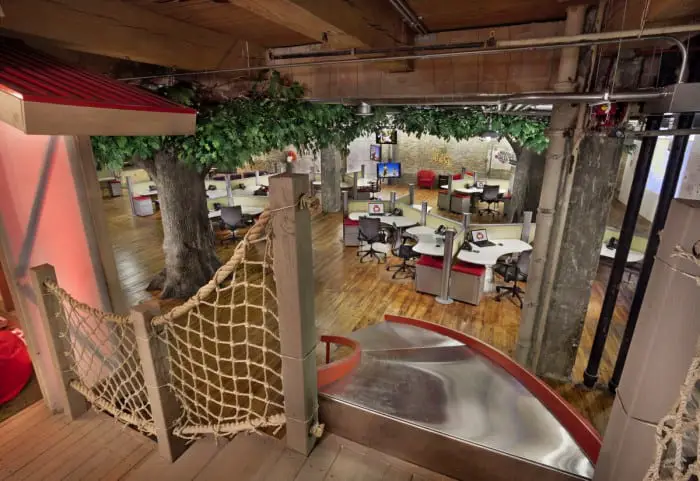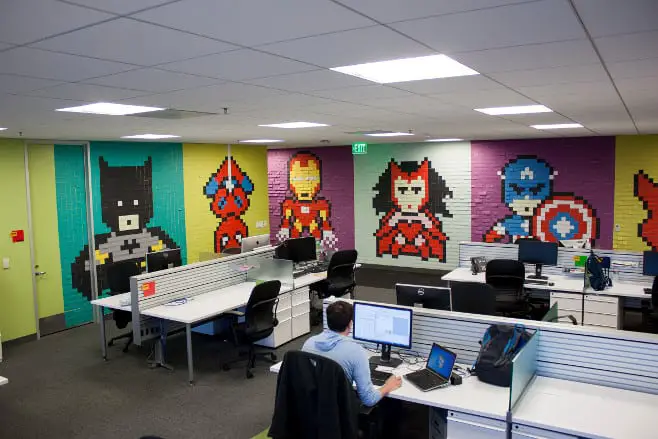You fondly remember the days of your childhood spent at the playground, riding on swings and catapulting down slides. Whether metal or plastic, the thrill they delivered was unmatched. Today, some offices have looked to recapture that same thrill with office slides. Does your company need its own slide and why?
Office slides add a sense of playfulness to the workplace. An office slide can lessen stress while adding to our:
- – Sense of trustworthiness in our clients and colleagues
- – Brain functioning
- – Creativity
- – Physical health
- – Productivity
In this article, we will fill you in on everything you need to know about office slides. From which companies already have them (including images!) to more on the benefits and how to get a slide in your own office, keep reading, as you don’t want to miss it.
Which Companies Have Office Slides?
While we can largely attribute the popularity of office slides to Google, today, they are far from the only company to have such a playful feature installed in their offices. Let’s talk more about the ones that do now.
As we said before, the forefather of today’s more fun office environment is undoubtedly Google. While the slides started at their Mountain View headquarters, these days, you can find slides in almost all their offices, including those in Zurich and Canada.
In fact, their slides have become so prevalent that Business Insider ranked them from worst to best. They gave the top spot to the Google YouTube building, rating that office’s slide a nine out of 10. Perhaps that’s because the slide has waves running all down its red plastic base. There are also three lanes so multiple people can join in on the fun! Here’s an image of the slide.
ranked them from worst to best. They gave the top spot to the Google YouTube building, rating that office’s slide a nine out of 10. Perhaps that’s because the slide has waves running all down its red plastic base. There are also three lanes so multiple people can join in on the fun! Here’s an image of the slide.




AWeber
In 2013, email marketing company AWeber moved to Chalfont, Pennsylvania, their new headquarters. With a blank slate in terms of office design, the brand decided to live up to its core values of having fun and not taking itself super seriously. Working with Wulff Architects, they designed a wide-open office that spans 71,000 square feet.
moved to Chalfont, Pennsylvania, their new headquarters. With a blank slate in terms of office design, the brand decided to live up to its core values of having fun and not taking itself super seriously. Working with Wulff Architects, they designed a wide-open office that spans 71,000 square feet.
In it, you’ll find a volleyball court, yoga room, several game spaces, and dual slides. These both ascend 14 feet and release you in the atrium. Oh, and did we mention this building got a gold certification from Leadership in Energy and Environmental Design or LEED? It’s fun and ecofriendly!

Box.net
Another office with a cool slide is Box.net . This content management and cloud storage platform wanted to draw in new hires. To that end, they hired Fennie+Mehl, architects, to make their office more appealing. The result? They too have a slide that spans two stories, letting you access two floors of the building. These cheery bright yellow slides would put anyone in a good mood before work.
. This content management and cloud storage platform wanted to draw in new hires. To that end, they hired Fennie+Mehl, architects, to make their office more appealing. The result? They too have a slide that spans two stories, letting you access two floors of the building. These cheery bright yellow slides would put anyone in a good mood before work.

Resignation Media
Resignation Media, also known as the Chive Media Group , is in charge of popular site theCHIVE. If you’d imagine their office as a fun place to work, you’d be correct. In 2014, the company settled in trendy downtown Austin, erecting a workspace that spans an impressive 14,000 square feet.
, is in charge of popular site theCHIVE. If you’d imagine their office as a fun place to work, you’d be correct. In 2014, the company settled in trendy downtown Austin, erecting a workspace that spans an impressive 14,000 square feet.
With so much room to fill, Chive Media Group sought out Chioco Design to come up with a structure that would encourage more sociability among colleagues. Hence, the wooden office slide in their office was born. It’s a wonder, so don’t miss it here !
!

Red Frog Events
Over in Chicago, production brand Red Frog Events pretty much has a playground in its midst. Designed like a treehouse, complete with faux trees and wooden walls and floors, their office includes steps with a rope bridge and a metal slide.
pretty much has a playground in its midst. Designed like a treehouse, complete with faux trees and wooden walls and floors, their office includes steps with a rope bridge and a metal slide.

Tate Modern
Arguably one of the coolest office slides you’ll come across is that at Tate Modern . This UK art museum network had its slides for quite a while, more than a decade, in fact! The installation took place in 2006, so Tate may have beat Google to the punch with this whole office slide thing.
. This UK art museum network had its slides for quite a while, more than a decade, in fact! The installation took place in 2006, so Tate may have beat Google to the punch with this whole office slide thing.
Carsten Holler designed and put up the slides, of which there are five. They’re all made of metal and are quite steep. They also have spirals all the way down. Museum guests can use three of the five slides, which could be exhibits in and of themselves!

What Are the Benefits of Office Slides?
You may wonder if it’s worth considering an office slide for your company. Sure, these make for a fantastic talking point, and they’ll surely attract attention to your brand for a while after the slides first appear in the office. You may even increase recruitment, but what are the other benefits?
- – Branding
- – Reduced Employee Turnover
- – Encouraged Collaboration
- – Healthier Employees
- – More Trust in Colleagues
- – Better Brain Function
- – More Creativity
- – Less Stress
- – Boosted Productivity
We talked about them in the intro, but let’s explain the many perks of office slides more now.
Branding
Today, companies are all about branding, not like they have much of a choice. With so many businesses out there, competition is more than a little stiff. You need a cohesive, strong brand to retain your customers and draw in new ones.
An office centered around fun and togetherness will really strengthen your brand, provided those are values you were after in the first place. We do want to say that if you have a more buttoned-up, serious company that maybe an office slide wouldn’t be your best choice for cohesive branding.
Reduced Employee Turnover
An employee’s title and even their pay isn’t necessarily the only reason they stay at a company. The environment in which they surround themselves also matters. Given that employees spend on average eight hours a day at an office, five days a week, for decades and decades at a time, they need a pleasant environment in which to work.
Sure, not every company can accommodate all its employees with plush offices for each, but stale, gray cubicles add drudgery to every day. Most workplaces with slides tend to have open, airy environments that invite in sunlight. These spaces also inspire fun just by looking at them.
A 2018 infographic from Talent Works International mentions that most employees (85 percent) do not like their workspace. The survey comes from 10,000 people in the workforce, who all cite concentration issues at the office as a major hindrance.
mentions that most employees (85 percent) do not like their workspace. The survey comes from 10,000 people in the workforce, who all cite concentration issues at the office as a major hindrance.

By changing your workspace, like adding an office slide, you can make your employees happier and potentially even keep them longer. Talent Works International says as much in their infographic. According to them, when employees like where they work, they cut down on sick days by a rate of 10x. They also stay 2x longer with the company.
Encouraged Collaboration
If you paid attention to the last section, then you may have noticed a common thread between those businesses. Many of the companies that got office slides did so to encourage more communication and collaboration between employees.
Imagine starting your workday going down a three-lane slide with another colleague. You’re bound to have a conversation after that kickstart to your day, and it probably won’t be about something mundane like the weather, either.
Healthier Employees
How many hours a day do you spend sitting at a computer? Probably most of them, right? According to data from Mayo Clinic , when they reviewed more than a dozen studies on the topic, they found that the longer you sit around, the more you worsen your health. If you don’t get up for over eight hours day after day after day, you have the same chances of dying as a person would if they smoked and were obese. You may also have a higher chance of getting and dying from cancer or cardiovascular disease.
, when they reviewed more than a dozen studies on the topic, they found that the longer you sit around, the more you worsen your health. If you don’t get up for over eight hours day after day after day, you have the same chances of dying as a person would if they smoked and were obese. You may also have a higher chance of getting and dying from cancer or cardiovascular disease.
Ouch. Not only that, but sedentary workers could also have unnaturally high cholesterol, more waist fat than active people, increased blood sugar, higher blood pressure, and obesity. The above issues do not a healthy person make.
Getting up, even for a few minutes, can help, especially if you take breaks in 30-minute intervals. You know what else can help? Sliding down a big, long office slide a time or two (or three).
More Trust in Colleagues
Do you not really care much for your coworkers? Try riding down an office slide with them. An article in HelpGuide on the importance of adult play mentions that when we have fun and even some laughs with someone, a myriad of good things happen. We improve our intimacy, trust, compassion, and empathy for that person.
on the importance of adult play mentions that when we have fun and even some laughs with someone, a myriad of good things happen. We improve our intimacy, trust, compassion, and empathy for that person.
Better Brain Function
HelpGuide also mentions how “the social interaction of playing” can keep our brains better at safeguarding us from depression and stress. You probably feel better on a day where you get to ride an office slide than on one where you don’t. Well, maybe with the exception of weekends.
More Creativity
All that activity and fun gets you in a creative headspace in which your ideas can soar. The next time you have a big office meeting, instead of sitting around in a stuffy conference room, why not have everyone ride the office slide instead? That will surely get some good brainstorming sessions going.
Less Stress
Our jobs can provide immense stress, but they can also take some of this stress away. Well, the workplaces with office slides can, at least. When you do something fun and exciting like ride a slide, our body makes endorphins. These brain chemicals improve our mood and put a smile on our face that can last all day. We also end up less stressed out as a result.
Boosted Productivity
You might think the temptation of an office slide and other play features might degrade productivity. It turns out, the opposite is true. The Receptionist, in the link we shared at the beginning of this article, mentions the importance of short breaks for maintaining our productivity. You know, like taking a break riding down the slide and then coming back to your office. It can help!
Other Features These Offices Often Have
Why stop at slides for your office? For a more productive, fun workplace, you might consider installing the following features as well.
Climbing Walls
Not only do climbing walls add to the aesthetic you’re going for in your more playful office, but they’re a great source of exercise for employees. Remember, you don’t want to sit around all day at an office, especially not longer than eight hours. Climbing walls will get you up and going.

As an added bonus, the Receptionist article cites data from the University of North Florida that discovered that climbing activities can assist us in problem-solving, learning, and memory. We don’t even have to spend long periods climbing to reap those benefits.
Bean Bags
Okay, so bean bags don’t help with our physical health, but they’re more comfortable to sit in than a stuffy office chair. If your office puts a few bean bags in a common area, employees might just sit down together, chat, and collaborate. You never know!
Hammocks
The same goes for hammocks. This comfy seating alternative acts as the perfect place to take a break in the middle of a hectic day. Plus, if your office allows for it, a hammock gives employees an opportunity to take a nap. According to Thrive Global , napping can boost our accuracy, motor skills, stamina, perception, creativity, and alertness. It also cuts down on stress and even our heart attack risk. We may also have a better memory and a happier mood, all from getting a little daytime shuteye.
, napping can boost our accuracy, motor skills, stamina, perception, creativity, and alertness. It also cuts down on stress and even our heart attack risk. We may also have a better memory and a happier mood, all from getting a little daytime shuteye.
Arcades
Some offices do have arcades. Employees might opt to spend their lunch hour here playing instead of going out to eat, which saves money. They may also bond. A 10-minute break at the office arcade can get an employee in a fun, energetic mood to finish out the day as well. That said, you do have to have a certain level of trust in employees, as an arcade can become a distraction fast.
Bar
The same goes for a bar. After hours, employees can hang out here for happy hour. This can boost bonds between employees and perhaps even foster creativity and collaboration. You’d have to have strict hours about bar usage, or at least serve only coffee during the day and then alcohol after office hours.
Having the Conversation about Getting an Office Slide Installed at Your Workplace
Adding a slide to your office is quite pricy. Also, given that most of these slides are multiple stories, you can’t just add one without making other wholesale office changes. That’s why many companies consider a slide only when a.) relocating or b.) building a new headquarters or office branch.
If your company is in either of those predicaments, then it’s worth having the conversation about potentially getting an office slide. Of course, you do want to think about the type of company you run, first. Remember, branding is important, and so is consistency within your branding. If your company doesn’t have a lighthearted approach to how you do business, then skip the office slide for now.
You must also take into account the expenses. If you’re getting an office slide, you want it done right. That often means recruiting renowned designers and/or architects for the job. Their work does not come cheap, as you can imagine.
That said, an office slide can pay itself off in other ways. As we talked about, your company will certainly get its share of the spotlight after getting your office slide installed. This positive press can result in more business. You may also notice a higher interest in recruitment as more people will want to check out this cool company with an office slide. Employee retention might increase or hold steady.
For those who can swing it, we’d say an office slide is absolutely worth having. You could have happier, healthier employees who feel closer to each other and still do great work.
Related Questions
What’s the consensus on office slides? As we’ve said, by no means does your business need an office slide. In fact, there’s a pretty vocal group of detractors to these slides and their role in the modern office. A 2017 BBC article doesn’t advocate as much for slides as it does other impressive architectural features in offices and workplaces. They cite the Wisconsin headquarters of Johnson Wax as one such marvel. This large open office has desks and cubicle walls, sure, but it also boasts lots of bright light and floor-to-ceiling columns. It’s not just another place to work.
article doesn’t advocate as much for slides as it does other impressive architectural features in offices and workplaces. They cite the Wisconsin headquarters of Johnson Wax as one such marvel. This large open office has desks and cubicle walls, sure, but it also boasts lots of bright light and floor-to-ceiling columns. It’s not just another place to work.
How else can you get the office in a more playful state without slides? If you prefer to forego slides and the other fun features described in this article, that’s okay. You may still want to generate a sense of playfulness among employees, so how can you do that? There are plenty of ways!
You might do any of the following:
- – Have office happy hours
- – Host ping-pong or foosball tournaments
- – Have a party
- – Lead a yoga or art class
- – Do an outdoor field day with employees
Join the Open Sourced Workplace Community
























